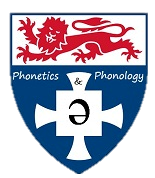-
News:
Accent Articulation Conference First Language Acquisition gamification Group focuses Job Laboratory Phonology Lecturer Linguistics Morphology Perception PhD Funding Phonetics Phonetics and Phonology Phonology Professor Project on Tyneside English Psycholinguistics R Research associate science open day Sociolinguistics Sociophonetics Speech Signal Analysis Speech signal processing statistics Workshop
Tag Archives: Group focuses
Kaleidoscopic boundary tones
Date: 24/10/2022 Cong Zhang gave us a talk on boundary tones in Mandarin. Background information: Intonational tunes are generally made up of pitch accents and edge/boundary tones. The intonation in a tonal language is difficult to phonologise as F0 can … Continue reading

